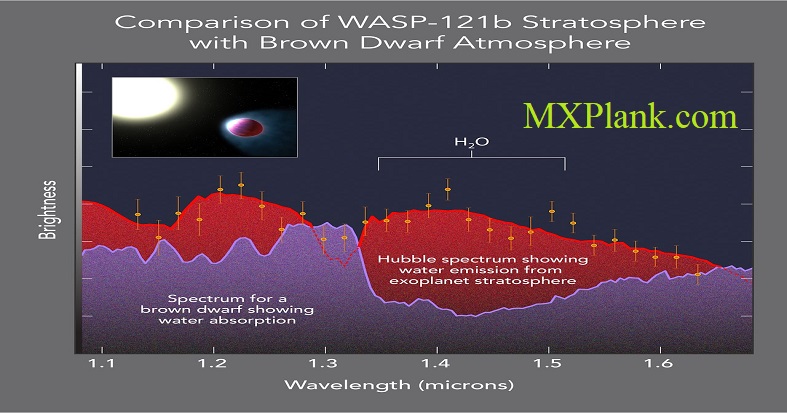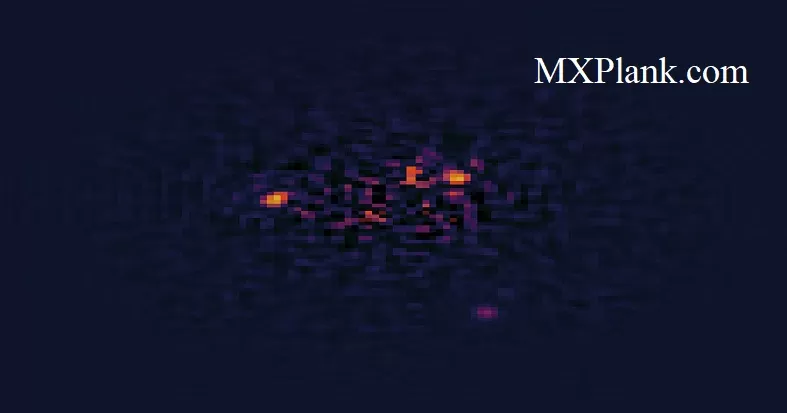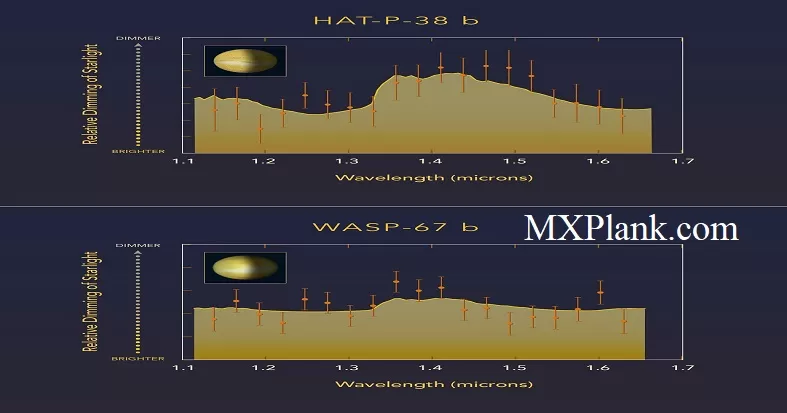COMPARISON OF WASP-121B STRATOSPHERE WITH BROWN DWARF ATMOSPHERE

This diagram presents evidence for the existence of a stratosphere on a planet orbiting another star. As on Earth, the stratosphere increases in temperature with altitude. The water emissions from the Jupiter-sized planet's upper atmosphere show this. The results are in marked contrast to the spectrum of a failed star, a brown dwarf, which shows water absorption because the atmosphere is cooling with altitude increase.
An international team, including researchers from the Institut d'astrophysique de Paris, have found evidence for a stratosphere around an enormous planet outside our solar system, with an atmosphere hot enough to boil iron. These results have been published on August 3rd, 2017 in the journal "Nature".
WASP-121b, located approximately 900 light-years from Earth, is a gas giant exoplanet commonly referred to as a "hot Jupiter", although with a greater mass and radius than Jupiter. The exoplanet orbits its host star every 1.3 days, and is at about the closest distance it could be before the star's gravity starts ripping it apart. This close proximity also means that the top of the atmosphere is heated to a blazing hot 2,500 degrees Celsius - the temperature at which iron exists in gas rather than solid form. Figure 1 shows an artist view of the star and companion planet.
In Earth's stratosphere, the second layer of the atmosphere located on the average between 10 and 50 km above ground, ozone traps ultraviolet radiation from the sun, which raises the temperature of this layer with increasing altitude (whereas the temperature decreases with altitude in the lower layer). Those processes produce the temperature stratification and stability of the layer, which is almost free of clouds and turbulence. The stratosphere is therefore an ideal atmospheric region for airlines to fly through over long distances.
Other solar system bodies have stratospheres too, that is a layer of the atmosphere where temperature increases with altitude. Methane is responsible for heating in the stratospheres of Jupiter, as well as Saturn's moon Titan, for example. In solar system planets, the change in temperature within a stratosphere is typically around a few tens of degrees Celsius. However, in the stratosphere of WASP-121b, there is a strong rise in temperature within the stratosphere, by 1000 degrees. The researchers do not yet know what is causing this dramatic heating. Upcoming observations at other wavelengths are necessary to better understand this phenomenon.Vanadium oxide and titanium oxide gases are candidate heat sources, as they strongly absorb starlight at visible wavelengths, similar to ozone absorbing UV radiation around the Earth. These compounds are expected to be present in only the hottest of "hot Jupiters" such as WASP-121b, as high temperatures are required to maintain them in the gaseous state.
By using NASA's Hubble Space Telescope, an international team of researchers, led by Tom Evans, research fellow at the University of Exeter (United Kingdom), observed glowing water molecules in the atmosphere of the exoplanet WASP-121b, which implies that the planet is surrounded by a significant stratosphere. In order to study this stratosphere, the researchers used spectroscopy to analyse how the planet's brightness changes at different wavelengths of light. Depending on its temperature, water vapour enclosed in the planet's atmosphere behaves in predictable ways in response to certain wavelengths of light. At rather cool temperatures, water vapour blocks light from beneath it. But at higher temperatures, the water molecules glow. Although water may be present in the entire atmosphere of the planet, it is the existence of a stratosphere, with its inverted temperature variation towards high values, that makes water glow.
The phenomenon is similar to what happens with fireworks, which get their colours from chemicals emitting light. When metallic substances are heated, and vaporised, their electrons move into higher energy states. Depending on the material, these electrons emit light at specific wavelengths as they lose energy: in this process, for example, sodium produces orange-yellow light and strontium red light. The water molecules in the atmosphere of WASP-121b similarly give off radiation as they lose energy, but it is in the form of infrared light, which the human eye is unable to detect. The infrared water emission of WASP-121b is shown in Figure 2 as a marked excess of light, in particular when compared with that of a brown dwarf[1] in which the water spectral feature appears instead as an absorption of the light emitted by the object.
Previous research spanning the past decade has found possible evidence for stratospheres on other exoplanets, but this is the first time that glowing water molecules have been detected. It is one of the first results to come out of a new observing program being led by Associate Professor David Sing at the University of Exeter (former post-doctoral fellow at the IAP) and Mercedes Lopez-Morales at the Harvard-Smithsonian Center for Astrophysics (USA), and conducted by an international team including researchers from France. The program has been awarded 800 hours to study and compare 20 different exoplanets, representing one of the largest time allocations for a single program in the entire 27 year history of the Hubble Space Telescope.
Among the studied hot exoplanets, WASP-121b can be used as a benchmark for the atmospheric models of exoplanets. These models suggest that stratospheres may define a special class of ultra-hot exoplanets, with important implications for the atmospheric physics and chemistry. WASP-121b also illustrates the dramatic planet-to-planet differences that can be observed. Comparison with other hot exoplanets should give clues on how planets behave under different conditions. NASA's forthcoming James Webb Space Telescope will be able to significantly enhance the research on the atmospheres of planets like WASP-121b with higher sensitivity than the Hubble Space Telescope.
[1] A brown dwarf is a star whose mass is insufficient to start thermonuclear fusion of hydrogen (but is more than 13 times the mass of a giant planet like Jupiter).
Credit:
NASA/ESA and The Hubble Heritage Team (STScI/AURA)
NASA/ESA and The Hubble Heritage Team (STScI/AURA)






